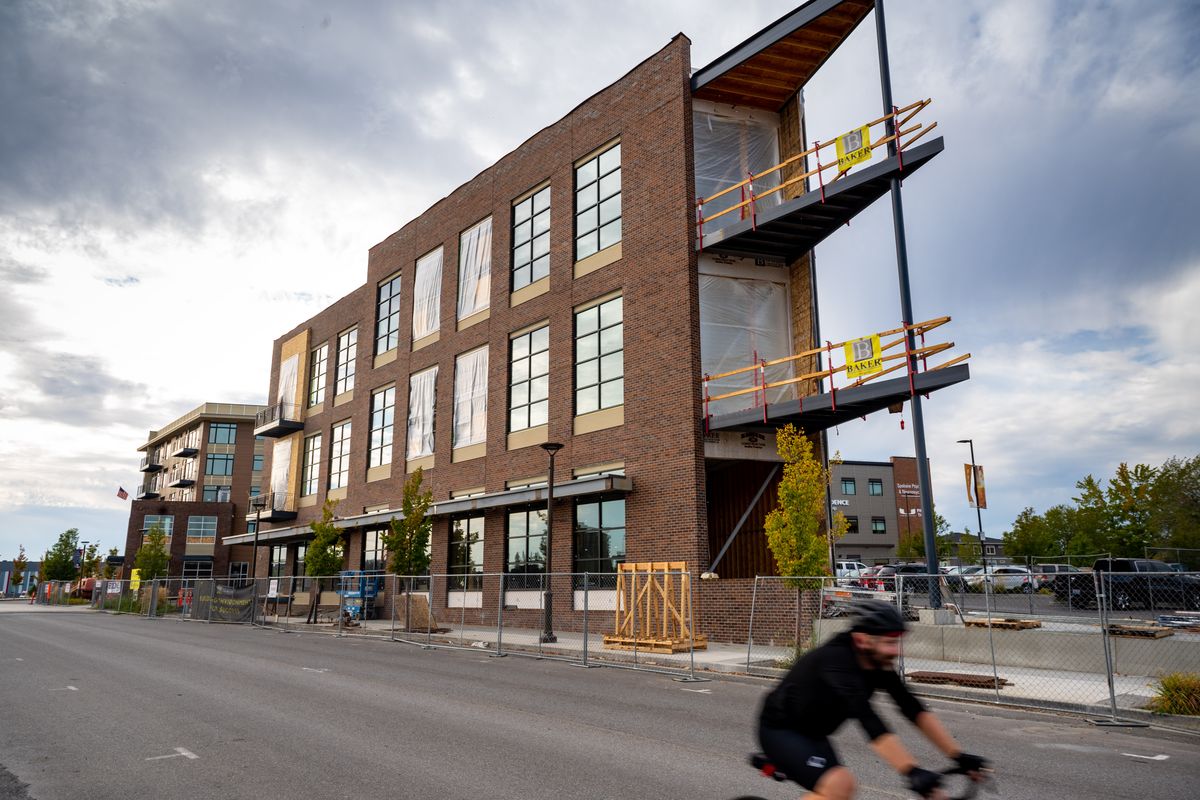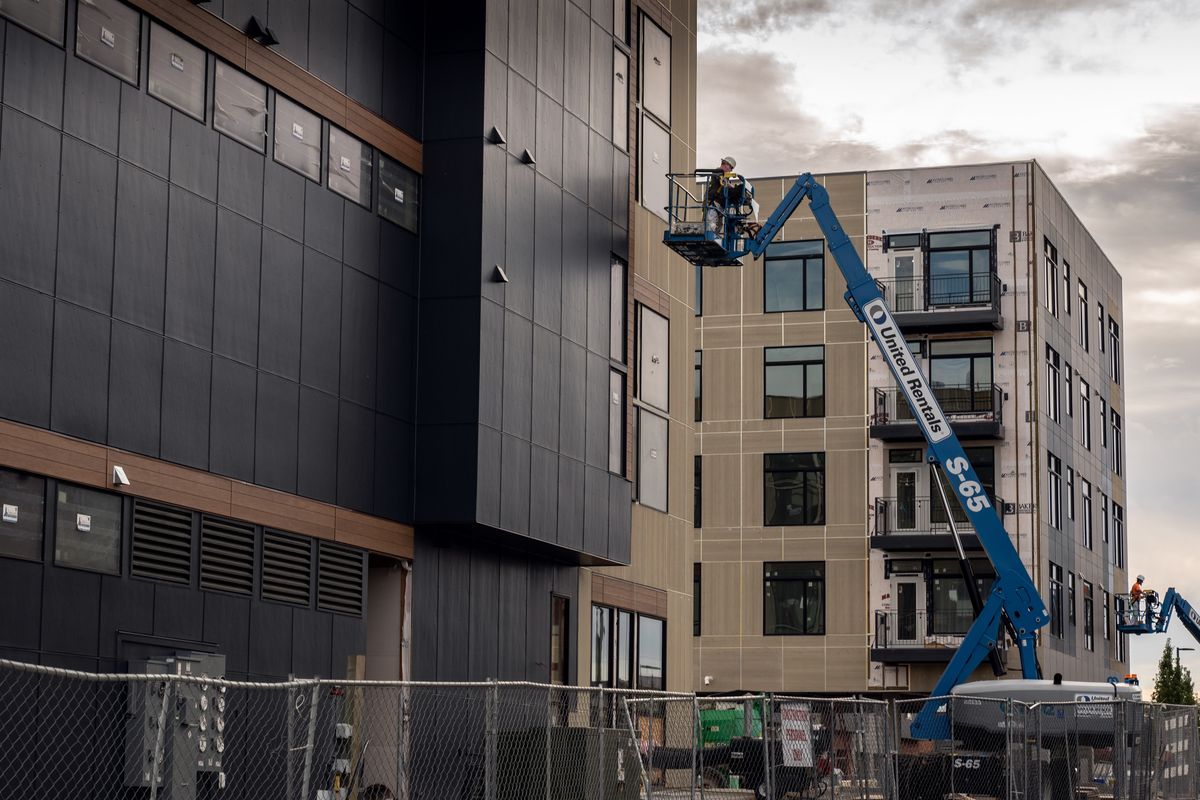Spokane County sets record with $1.3 billion in new construction in 2021: ‘Demand was just enormous’
Two mixed-use buildings – the FlatIron building (front) and the West of Jefferson building – are shown Monday under construction in the Kendall Yards Business District. (COLIN MULVANY/THE SPOKESMAN-REVI)
Spokane County set a record this year with $1.3 billion in new construction. But builders say you have to look deeper to understand the whole story.
“Building permits haven’t gone up,” said Joel White, executive officer of the Spokane Home Builders Association. “It’s really the cost of homes that has gone up.”
In other words: The value of new construction hit an all-time high because building a home has never been more expensive. But the number of new projects wasn’t unprecedented – although the last year has been one of the biggest construction years in county history.
Spokane County’s construction year begins on Aug. 1 and ends on July 31. The $1.3-billion record represents all new construction that occurred from Aug. 1, 2020, to July 31, 2021, and tops the old high of $1.1 billion set in 2007.
Tom Konis, Spokane County’s assessor, said one way to track the amount of new construction is to look at the number of property parcels where construction occurred.
During the 2021 construction year, the county saw new projects on 5,350 property parcels. That’s up from 4,953 in 2020. It’s also the most parcels to have new construction since 2006, when buildings went up on 5,411 parcels.
Housing permit statistics also suggest that while building is booming, construction hasn’t quite surpassed pre-Great Recession heights.
According to Construction Monitor, Spokane County is on pace to add 3,513 new housing units in 2021 – there have been 2,635 units built through September.
Construction typically tails off during the fall and winter, but the county should easily top the 2,720 units added last year. The county’s all-time record for new units added is 3,795, set in 2004.

In terms of single-family construction, the county didn’t come close to setting a record. Through September, Spokane County has gained 1,198 new single-family detached homes, according to Construction Monitor. That’s well below the 2,649 single-family homes construction crews built in 2005, but it’s a 13% increase compared to 2020.
“We are not near the level of construction we were at during the housing boom of the mid-2000s,” White said.
Residential construction was the main driver of the $1.3-billion record, not commercial construction, Konis said. He noted that about 60% of last year’s construction was from residential projects, while 40% was from commercial projects. About 80% of next year’s permits are for residential construction.
White and Konis both said that, even after adding caveats to the $1.3-billion figure, the record is still a huge deal.
“It was definitely a boom period as far as the amount of homes being built and the demand,” White said. “The demand was just enormous, and it’s real demand, this is not investors coming in.”
Corey Condron, CEO and owner of Condron Homes, said the county would have had a lot more than $1.3 billion in new construction if builders weren’t facing a handful of obstacles. Builders can’t keep up with the demand, he said.
“The three bigs that go into construction – land, labor and lumber – all three of them have spiked unprecedentedly in the last 18 months,” Condron said.
Land is increasingly expensive, builders can’t find enough workers and lumber costs hit record highs during the last year. All of those factors, in addition to slower permitting, materials shortages and a lack of appraisers, have restricted development, Condron said.
“We’re still not keeping up with the market,” he said. “If we were keeping up with market demand, that number ($1.3 billion) would be triple what it is.”
Konis said the county has had three great construction years in a row, topping the $1-billion plateau every year since 2019.
For context, after the county set a record with $1.1 billion in new construction in 2007, building slowed dramatically. In 2011, new construction was worth $283 million and from 2009 through 2013 the county never topped the $500-million threshold.
Taxpayers benefit from the building boom, Konis explained.
Government budgets can go up by 1% per year. But adding new construction value spreads the tax burden across a greater number of properties, so overall new construction helps lower everyone’s property taxes.
“It adds to the base that everybody is divvying up the taxes from,” Konis said.
Konis said the county already has $1.4 billion in new construction permitted for 2022. That’s a “scary” figure for late September, he said.
For now, it looks like construction will maintain its relentless pace for a while longer.
“There’s no sign of it slowing,” Konis said. “Unless something major happens, be it a war, be it COVID gets worse, be it the Fed raises the interest rate … I don’t see it slowing down.”

